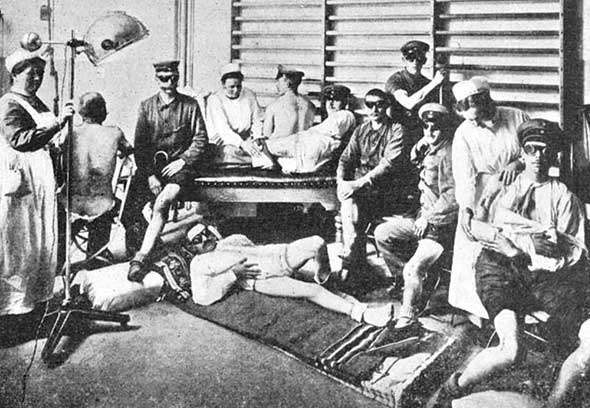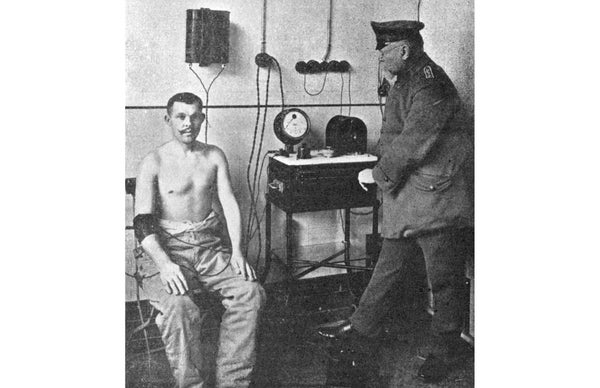This article was published in Scientific American’s former blog network and reflects the views of the author, not necessarily those of Scientific American
After a year and a half of war, casualties had depleted armies of their original manpower, industries were being drained of their workers and women were being recruited into jobs that had been up to now closed to them. This article about experimental military medicine is not about the works of mercy and healing, but about fixing up wounded, injured and sick men so that they could be fit enough to return to the fighting as soon as possible. Those tasked with replenishing the ranks of the armed forces may have been desperate to try any medical method that might speed the process of recovery:
During the present war, when thousands upon thousands of brave soldiers are received in field hospitals, nothing is, of course, left untried in order to re-establish them as promptly as possible, so that they may, if feasible, return to the front at the earliest possible moment. Modern science is therefore resorted to and expected to press into service all its valuable achievements. Even the most recent discoveries and inventions, those not yet adopted by ordinary medical practice, are made use of and are doing excellent work.
Luckily for the patients involved, none of the treatments “not yet adopted by ordinary medical practice” seem to be particularly dangerous—and some may even have had some side benefits:
On supporting science journalism
If you're enjoying this article, consider supporting our award-winning journalism by subscribing. By purchasing a subscription you are helping to ensure the future of impactful stories about the discoveries and ideas shaping our world today.

Tanning the wounded, Germany, 1916: treatment with “artificial sun” proved beneficial—or perhaps it was just the time spent in a rest area away from the trenches.
Image: Scientific American Supplement, February 19, 1916
Just a few words on Artificial Sun Baths to begin with. There is hardly any curative agent that has had so prominent a part in the history of medicine as sunlight. Man at all times instinctively sought recovery from his ailments on mountain tops, where the beams of the sun are allowed to act more freely than down below; common experience shows man, animals and plants to languish in the thick atmosphere of cities, impenetrable to sunlight.... In fact the lamp designed on plans by Dr. Hugo Bach, of Elster, Germany, by the Quartz Lamp Company, Ltd., of Hanau-on-Main, gives out in abundance the chemically—and medically—effective rays of the spectrum .... Comprehensive tests have been made with this lamp (“Artificial Mountain Sun,” as it is termed by its inventor) in German military hospitals, the results being so encouraging that artificial sun baths are now employed in a great number of field hospitals, both in Germany and Austria-Hungary. The beams from the lamp act absolutely like sunshine, to the extent that even sunburn is produced, an unmistakable symptom, by the way, of a successful cure.
These photographs were taken at the Siemensstadt Military Hospital, the hospital sponsored by the Siemens company on their grounds on the outskirts of Berlin. Other treatments at this hospital included warming wounds with electric heating pads (the first image above). One can well imagine the exhausted infantryman, having spent months in or near the front line in squalid conditions in the freezing cold or rain, coming to this hospital with a few light wounds, frostbite or what the article terms “trench diseases.” After a regimen that included tanning beds (which boosted vitamin D), quiet wards, being clean and dry, getting good sleep and eating regular hot meals, the average patient no doubt regained health rapidly.
-
Our full archive of the war, called Scientific American Chronicles: World War I, has many articles from 1914–1918 on medicine in the First World War. It is available for purchase at www.scientificamerican.com/products/world-war-i/
